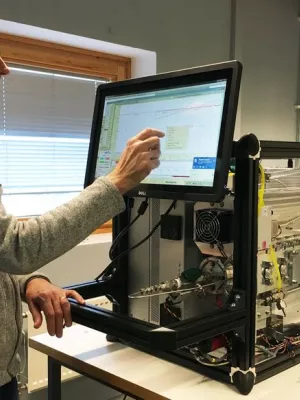
Erik Swietlicki
Professor

Source apportionment of the summer time carbonaceous aerosol at Nordic rural background sites
Author
Summary, in English
In the present study, natural and anthropogenic sources of particulate organic carbon (OCp) and elemental carbon (EC) have been quantified based on weekly filter samples of PM10 (particles with aerodynamic diameter < 10 mu m) collected at four Nordic rural background sites [Birkenes (Norway), Hyytiala (Finland), Vavihill (Sweden), Lille Valby, (Denmark)] during late summer (5 August-2 September 2009). Levels of source specific tracers, i.e. cellulose, levoglucosan, mannitol and the C-14/C-12 ratio of total carbon (TC), have been used as input for source apportionment of the carbonaceous aerosol, whereas Latin Hypercube Sampling (LHS) was used to statistically treat the multitude of possible combinations resulting from this approach. The carbonaceous aerosol (here: TCp; i.e. particulate TC) was totally dominated by natural sources (69-86%), with biogenic secondary organic aerosol (BSOA) being the single most important source (48-57%). Interestingly, primary biological aerosol particles (PBAP) were the second most important source (20-32%). The anthropogenic contribution was mainly attributed to fossil fuel sources (OCff and ECff) (10-24%), whereas no more than 3-7% was explained by combustion of biomass (OCbb and ECbb) in this late summer campaign i.e. emissions from residential wood burning and/or wild/agricultural fires. Fossil fuel sources totally dominated the ambient EC loading, which accounted for 4-12% of TCp, whereas < 1.5% of EC was attributed to combustion of biomass. The carbonaceous aerosol source apportionment showed only minor variation between the four selected sites. However, Hyytiala and Birkenes showed greater resemblance to each other, as did Lille Valby and Vavihill, the two latter being somewhat more influenced by anthropogenic sources. Ambient levels of organosulphates and nitrooxy-organosulphates in the Nordic rural background environment are reported for the first time in the present study. The most abundant organosulphate compounds were an organosulphate of isoprene and nitrooxy-organosulphates of alpha- and beta-pinene and limonene.
Department/s
- Department of Physics
- Nuclear physics
- MERGE: ModElling the Regional and Global Earth system
Publishing year
2011
Language
English
Pages
13339-13357
Publication/Series
Atmospheric Chemistry and Physics
Volume
11
Issue
24
Full text
- Available as PDF - 821 kB
- Download statistics
Document type
Journal article
Publisher
Copernicus GmbH
Topic
- Subatomic Physics
Status
Published
Research group
- AMS, Nuclear Physics
ISBN/ISSN/Other
- ISSN: 1680-7324